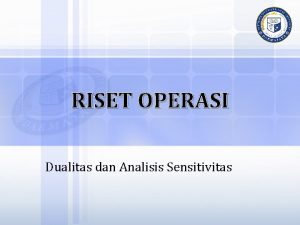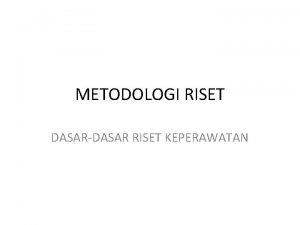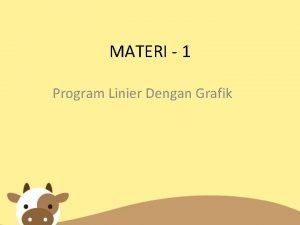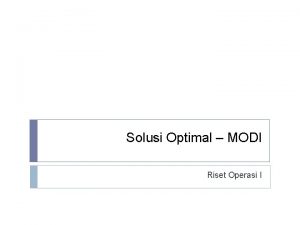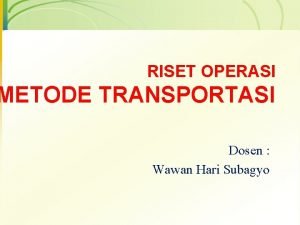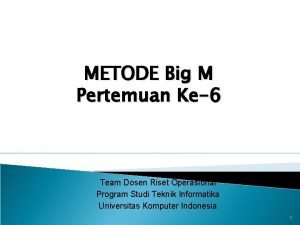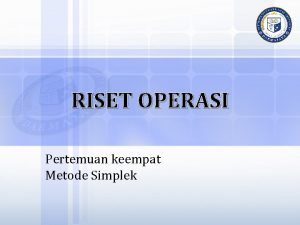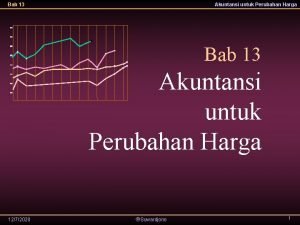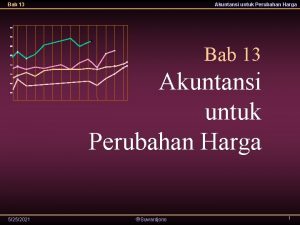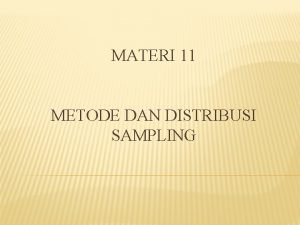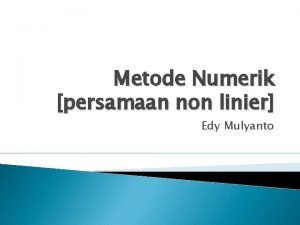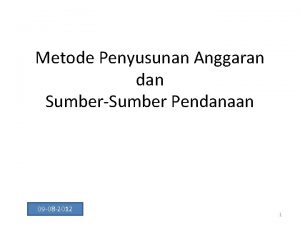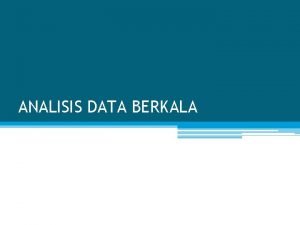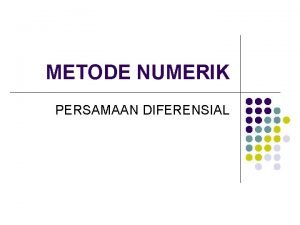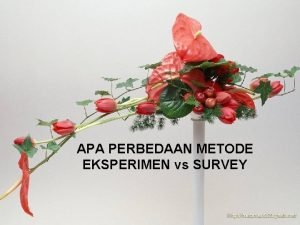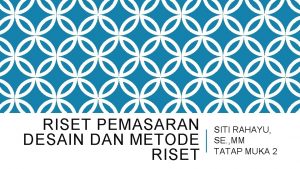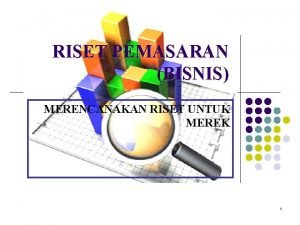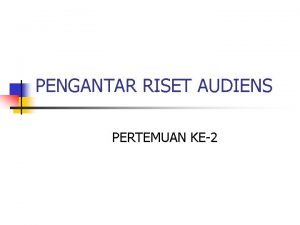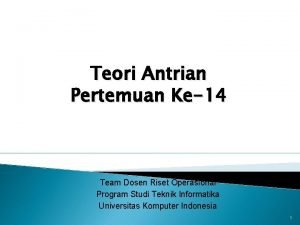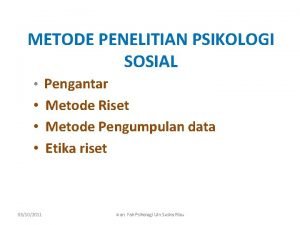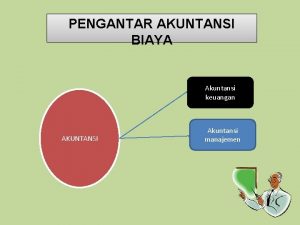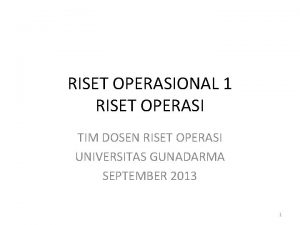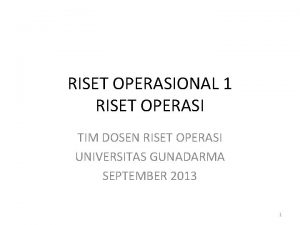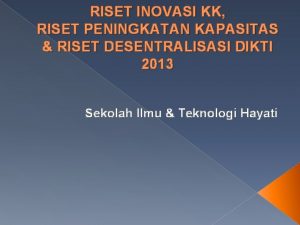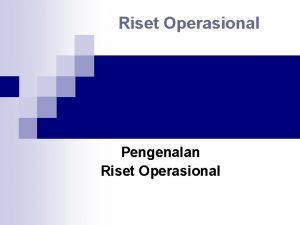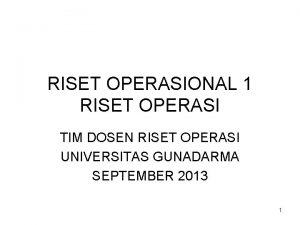Metode Riset Akuntansi Measurement and Sampling Measurement l































































- Slides: 63

Metode Riset Akuntansi Measurement and Sampling

Measurement l Measurement in research consists of assigning numbers to empirical events, objects, or properties, or activities in compliance with a set of rules

Measurement Selecting measurable phenomena Developing a set of mapping rules Applying the mapping rule to each phenomenon

Measurement Scales l Several types of measurement are possible l l Depends on what you assume about mapping rule Mapping rules have four characteristics: Classification l Order l Distance l Origin l

Types of Scales Nominal Ordinal Interval Ratio

Levels of Measurement Nominal Ordinal Interval Ratio Classification

Levels of Measurement Nominal Ordinal Interval Ratio Classification Order

Levels of Measurement Nominal Classification Order Interval Classification Order Ratio Distance

Levels of Measurement Nominal Classification Order Interval Classification Order Distance Ratio Classification Order Distance Natural Origin

Sources of Error Respondent Situation Measurer Instrument

Evaluating Measurement Tools Validity Criteria Practicality Reliability

Evaluating Measurement Tools Validity is the extent to which a test measures what we actually wish to measure l Reliability has to do with the accuracy and precision of a measurement procedure l Practicality is concerned with a wide range of factors of economy, convenience, and interpretability l

Validity l Two major forms: External validity: data’s ability to be generalized l Internal validity: the ability of a research instrument to measure what it is purported to measure l

Validity Determinants Content Criterion Construct

Content Validity l The extent to which it provides adequate coverage of the investigative questions guiding the study

Increasing Content Validity Literature Search Content Expert Interviews Group Interviews

Validity Determinants Content Construct

Construct Validity l Consider both theory and the measuring instrument being used

Validity Determinants Content Criterion Construct

Criterion-Related Validity l Reflects the success of measures used for prediction or estimation

Understanding Validity and Reliability

Reliability Estimates Stability Internal Consistency Equivalence

Practicality Economy Convenience Interpretability

Methods of Scaling l Rating scales l l Have several response categories and are used to elicit responses with regard to the object, event, or person studied. Ranking scales l Make comparisons between or among objects, events, persons and elicit the preferred choices and ranking among them.

Simple Category/Dichotomous Scale I plan to purchase a Mind. Writer laptop in the 12 months. q. Yes q. No Nominal Data

Multiple-Choice, Single Response Scale What newspaper do you read most often for financial news? q. East City Gazette q. West City Tribune q. Regional newspaper q. National newspaper q. Other (specify: _______) Nominal Data

Multiple-Choice, Multiple Response Scale What sources did you use when designing your new home? Please check all that apply. q. Online planning services q. Magazines q. Independent contractor/builder q. Designer q. Architect q. Other (specify: _______) Nominal Data

Likert Scale The Internet is superior to traditional libraries for comprehensive searches. q. Strongly disagree q. Disagree q. Neither agree nor disagree q. Agree q. Strongly agree Interval Data

Semantic Differential Interval Data

Numerical Scale Ordinal or Interval Data

Multiple Rating List Scales Interval Data

Stapel Scales Interval Data

Constant-Sum Scales Interval Data

Graphic Rating Scales Interval Data

Ranking Scales l l l Paired-comparison scale Forced ranking scale Comparative scale

Paired-Comparison Scale Ordinal Data

Forced Ranking Scale Ordinal Data

Comparative Scale Ordinal or Interval Data

The Nature of Sampling l The basic idea of sampling is that by selecting some of the elements in a population, we may draw conclusions about the entire population

The Nature of Sampling l l Population element: the individual participant or object on which the measurement is taken Population: total collection of elements about which we wish to make some inferences Census: a count of all the elements in a population Sample frame: listing of all population elements from which the sample will be drawn

Why Sample? Availability of elements Greater speed Lower cost Sampling provides Greater accuracy

What Is A Good Sample? Accuracy Precision

Accuracy l Accuracy is the degree to which bias is absent from the sample Systematic variance l Increasing the sample size l

Precision l A measure of how closely the sample represents the population l Measured by the standard error of estimate

Sampling Designs l Probability sampling l l Elements in the population have some known chance or probability of being selected as sample subjects Nonprobability sampling l Elements do not have known or predetermined chance of being selected as subjects

Types of Sampling Designs Element Selection Unrestricted Probability Nonprobability Simple random Convenience Restricted Complex random Purposive Systematic Judgment Cluster Quota Stratified Double Snowball

Simple Random l Purest form of probability sampling

Simple Random Advantages l Easy to implement Disadvantages l Requires list of population elements l Time consuming l Can require larger sample sizes

Systematic l Every kth element in the population is sampled, beginning with a random start of an element in the range of 1 to k

Systematic Advantages l Simple to design l Easier than simple random Disadvantages l Periodicity within population may skew sample and results l Trends in list may bias results

Stratified l The process by which the sample is constrained to include elements from each of the segments

Stratified Advantages l Increased statistical efficiency l Provides data to represent and analyze subgroups l Enables use of different methods in strata Disadvantages l Especially expensive if strata on population must be created

Stratified Proportionate: sample drawn from the stratum is proportionate to the stratum’s share of the total population l Disproportionate l

Cluster Advantages l Economically more efficient than simple random l Easy to do without list Disadvantages l Often lower statistical efficiency due to subgroups being homogeneous rather than heterogeneous

Stratified and Cluster Sampling Stratified l Population divided into few subgroups l Homogeneity within subgroups l Heterogeneity between subgroups l Choice of elements from within each subgroup Cluster l Population divided into many subgroups l Heterogeneity within subgroups l Homogeneity between subgroups l Random choice of subgroups

Area Sampling

Double l It may be more convenient or economical to collect some information by sample and then use this information as the basis for selecting a subsample for further study

Double Advantages l May reduce costs if first stage results in enough data to stratify or cluster the population Disadvantages l Increased costs if discriminately used

Nonprobability Sampling No need to generalize Limited objectives Feasibility Issues Time Cost

Nonprobability Sampling Methods Convenience Judgment Quota Snowball

Convenience l Collection of information from members of the population who are conveniently available to provide it

Purposive l Conform to some criteria set by the researcher Judgment sampling l Quota sampling l

Snowball l Individuals are discovered and this group is then used to refer the researcher to others that possess similar characteristics and who, in turn, will identify others
 Contoh soal dualitas dan analisis sensitivitas
Contoh soal dualitas dan analisis sensitivitas Beberapa metode riset keperawatan yaitu
Beberapa metode riset keperawatan yaitu Model program linear riset operasi
Model program linear riset operasi Contoh soal metode penugasan
Contoh soal metode penugasan Metode modi
Metode modi Contoh soal transportasi riset operasi
Contoh soal transportasi riset operasi Metode big m minimasi
Metode big m minimasi Metode big m riset operasi
Metode big m riset operasi Riset operasi metode simpleks
Riset operasi metode simpleks Probability vs non probability sampling
Probability vs non probability sampling Panel sampling
Panel sampling Stratified sampling
Stratified sampling Contoh time sampling dalam observasi
Contoh time sampling dalam observasi Cluster sampling vs stratified sampling
Cluster sampling vs stratified sampling Non-probability sampling method
Non-probability sampling method Natural sampling vs flat top sampling
Natural sampling vs flat top sampling Persamaan antara akuntansi keuangan dan akuntansi manajemen
Persamaan antara akuntansi keuangan dan akuntansi manajemen Teori akuntansi bab 13 akuntansi untuk perubahan harga
Teori akuntansi bab 13 akuntansi untuk perubahan harga Peranan akuntansi kos bagi manajemen adalah:
Peranan akuntansi kos bagi manajemen adalah: Teori akuntansi bab 13 akuntansi untuk perubahan harga
Teori akuntansi bab 13 akuntansi untuk perubahan harga Teori akuntansi bab 13 akuntansi untuk perubahan harga
Teori akuntansi bab 13 akuntansi untuk perubahan harga Hubungan akuntansi biaya dengan akuntansi keuangan
Hubungan akuntansi biaya dengan akuntansi keuangan Sifat umum akuntansi keuangan dan akuntansi manajemen
Sifat umum akuntansi keuangan dan akuntansi manajemen Distribusi sampling beda dua proporsi
Distribusi sampling beda dua proporsi Metode sampling udara ambien
Metode sampling udara ambien Contoh soal metode laba kotor
Contoh soal metode laba kotor Perubahan metode akuntansi dan koreksi kesalahan
Perubahan metode akuntansi dan koreksi kesalahan Perubahan metode akuntansi dan koreksi kesalahan
Perubahan metode akuntansi dan koreksi kesalahan Prosedur akuntansi untuk metode harga pokok
Prosedur akuntansi untuk metode harga pokok Metode survei konsumsi pangan
Metode survei konsumsi pangan Metode-metode survei konsumsi makanan
Metode-metode survei konsumsi makanan Pentingnya kesejahteraan karyawan adalah …. *
Pentingnya kesejahteraan karyawan adalah …. * Metode metode dalam psikologi pendidikan
Metode metode dalam psikologi pendidikan Metode tertutup metode numerik
Metode tertutup metode numerik Metode kotor dan metode bersih
Metode kotor dan metode bersih Metode harga pokok lanjutan
Metode harga pokok lanjutan Contoh soal metode bagi dua metode numerik
Contoh soal metode bagi dua metode numerik Metode penyusunan anggaran
Metode penyusunan anggaran Metode bruto dan metode netto
Metode bruto dan metode netto Contoh soal metode trend tangan bebas
Contoh soal metode trend tangan bebas Metode euler metode numerik
Metode euler metode numerik Perbedaan penelitian eksperimen dan survey
Perbedaan penelitian eksperimen dan survey Pengertian riset pemasaran
Pengertian riset pemasaran Desain riset pemasaran
Desain riset pemasaran Mengembangkan rencana riset
Mengembangkan rencana riset Pengertian riset operasional
Pengertian riset operasional Model jaringan riset operasi
Model jaringan riset operasi Ruang lingkup riset operasi pdf
Ruang lingkup riset operasi pdf Contoh kasus penerapan riset operasi dalam dunia nyata
Contoh kasus penerapan riset operasi dalam dunia nyata Riset periklanan
Riset periklanan Riset audiens adalah
Riset audiens adalah Penelitian korelasional
Penelitian korelasional Isu dan riset kontemporer corporate governance
Isu dan riset kontemporer corporate governance Sistem informasi global dan riset pasar
Sistem informasi global dan riset pasar Elemen dasar riset komunikasi
Elemen dasar riset komunikasi Contoh riset aksi
Contoh riset aksi Teori antrian riset operasi
Teori antrian riset operasi Kegunaan riset operasional
Kegunaan riset operasional Riset periklanan
Riset periklanan Riset rating dan non rating
Riset rating dan non rating Masalah penugasan riset operasi
Masalah penugasan riset operasi Contoh gap riset
Contoh gap riset Contoh research gap
Contoh research gap Sistematika mini riset
Sistematika mini riset
